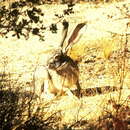en
names in breadcrumbs


Jackrabbits obtained their name from early settlers of the Southwest who, noting the animal's extraordinarily long ears, dubbed it "jackass rabbit." This name was later shortened to jackrabbit. This species has 8 named subspecies.
Perception Channels: tactile ; chemical
Population numbers of black-tailed jackrabbits are sometimes quite high despite attempts at culling their populations by ranchers and farmers. Population densities often reach 470 animals per square km, with densities as high as 1500 animals per square km being recorded. Large herding attempts have netted as much as 6,000 hares at a time. As with many hares, Lepus californicus populations undergo drastic fluctuations, with population numbers peaking every 6 to 10 years. In some years more then 90 per cent of western populations die from tularemia, which may or may not be related to the population cycling phenomenon. Because of their incredible fecundity, black-tailed jackrabbit numbers quickly recover from these kinds of die-offs.
Black-tailed jackrabbit populations are not threatened in general, though extensive habitat destruction may reduce suitable habitat.
US Federal List: no special status
CITES: no special status
IUCN Red List of Threatened Species: least concern
Due to the removal of natural predators, such as coyote and kit fox, by European settlers, black-tailed jackrabbit populations have undergone incredible population explosions in which crops, orchards, and rangelands have suffered. They do considerable damange to farms, forest plantations, and young trees.
Negative Impacts: crop pest
As with many other Lepus species, L. californicus has been widely used as food for humans, especially by Native Americans. Their fur is not durable nor valuable, but it has been extensively used in the manufacture of felt and as trimming and lining for garments and gloves.
Positive Impacts: food ; body parts are source of valuable material
Grasses and herbaceous matter are the preferred foods of Lepus californicus, but twigs and young bark of woody plants are the staple food when other plants are not available. Sagebrush and cacti are also taken. Jackrabbits eat almost constantly and consume large quantities relative to their size; 15 jackrabbits eat as much as a large grazing cattle in one day. Black-tailed jackrabbits do not require much water and obtain nearly all the water they need from the plant material they consume.
Plant Foods: leaves; roots and tubers; wood, bark, or stems; fruit
Primary Diet: herbivore (Folivore )
Lepus californicus is found throughout the southwestern United States into Mexico, as far east as Missouri, north into Washington, Idaho, Colorado and Nebraska, and west to California and Baja California.
Biogeographic Regions: nearctic (Native )
Black-tailed jackrabbits inhabit desert scrubland, prairies, farmlands, and dunes. They favor arid regions and areas of short grass rangeland from sea level to about 3,800 m. Many different vegetation types are used, including sagebrush-creosote bush, mesquite-snakeweed and juniper-big sagebrush. They also frequent agricultural areas where they can impact fruit and grain crops.
Range elevation: 3800 (high) m.
Habitat Regions: temperate ; terrestrial
Terrestrial Biomes: desert or dune ; savanna or grassland ; chaparral
Other Habitat Features: suburban ; agricultural
Average lifespan
Status: captivity: 6.8 years.
Black-tailed jackrabbits measure 47-63 cm from nose to rump, the tail is between 50-112 mm and the ears are 10-13 cm long. As they are true hares, black-tailed jackrabbits are lankier and leaner than rabbits, have longer ears and legs, and the leverets are born fully-furred and open-eyed. Black-tailed jackrabbits possess a characteristic black stripe down the center of the back, a black rump patch, and the tail is black dorsally. Both sexes look alike, but the female is the larger of the two sexes.
Range mass: 1.3 to 3.1 kg.
Range length: 47 to 63 cm.
Other Physical Features: endothermic ; homoiothermic; bilateral symmetry
Sexual Dimorphism: female larger
Average basal metabolic rate: 7.314 W.
Black-tailed jackrabbit males and females leap after, chase, and behave aggressively towards each other during a brief courtship phase before mating.
Mating System: polygynandrous (promiscuous)
Breeding season for Lepus californicus extends from December through September in Arizona and from late January to August in California and Kansas. Females produce 3 or 4 litters annually with 1-6 leverets (generally 3 or 4) after a 41-47 day gestation period. The young are precocial; females only nurse their offspring for 2-3 days and are not seen with their young after that time. Lifespan in captivity is 5-6 years, but rabbits in the wild often die much sooner due to predation, disease or problems associated with overpopulation.
Range number of offspring: 1 to 8.
Average number of offspring: 2.26.
Range gestation period: 41 to 47 days.
Average gestation period: 43 days.
Range weaning age: 14 to 21 days.
Key Reproductive Features: gonochoric/gonochoristic/dioecious (sexes separate); sexual
Average birth mass: 84.34 g.
Average number of offspring: 1.
Average age at sexual or reproductive maturity (female)
Sex: female: 243 days.
Parental Investment: precocial